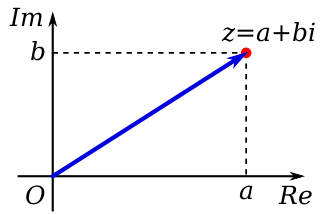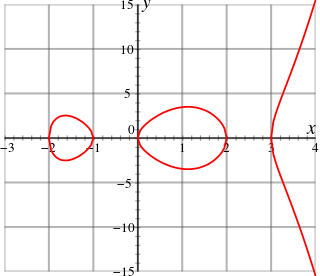
Complex analysis, traditionally known as the theory of functions of a complex variable, is the branch of mathematical analysis that investigates functions of complex numbers. It is helpful in many branches of mathematics, including algebraic geometry, number theory, analytic combinatorics, applied mathematics; as well as in physics, including the branches of hydrodynamics, thermodynamics, and particularly quantum mechanics. By extension, use of complex analysis also has applications in engineering fields such as nuclear, aerospace, mechanical and electrical engineering.

In mathematics, a complex number is an element of a number system that contains the real numbers and a specific element denoted i, called the imaginary unit, and satisfying the equation i2 = −1. Moreover, every complex number can be expressed in the form a + bi, where a and b are real numbers. Because no real number satisfies the above equation, i was called an imaginary number by René Descartes. For the complex number a + bi, a is called the real part and b is called the imaginary part. The set of complex numbers is denoted by either of the symbols or C. Despite the historical nomenclature "imaginary", complex numbers are regarded in the mathematical sciences as just as "real" as the real numbers and are fundamental in many aspects of the scientific description of the natural world.
In the mathematical field of complex analysis, elliptic functions are a special kind of meromorphic functions, that satisfy two periodicity conditions. They are named elliptic functions because they come from elliptic integrals. Originally those integrals occurred at the calculation of the arc length of an ellipse.

In mathematics, particularly in complex analysis, a Riemann surface is a connected one-dimensional complex manifold. These surfaces were first studied by and are named after Bernhard Riemann. Riemann surfaces can be thought of as deformed versions of the complex plane: locally near every point they look like patches of the complex plane, but the global topology can be quite different. For example, they can look like a sphere or a torus or several sheets glued together.

In mathematics, complex geometry is the study of geometric structures and constructions arising out of, or described by, the complex numbers. In particular, complex geometry is concerned with the study of spaces such as complex manifolds and complex algebraic varieties, functions of several complex variables, and holomorphic constructions such as holomorphic vector bundles and coherent sheaves. Application of transcendental methods to algebraic geometry falls in this category, together with more geometric aspects of complex analysis.

In mathematics, particularly in algebraic geometry, complex analysis and algebraic number theory, an abelian variety is a projective algebraic variety that is also an algebraic group, i.e., has a group law that can be defined by regular functions. Abelian varieties are at the same time among the most studied objects in algebraic geometry and indispensable tools for much research on other topics in algebraic geometry and number theory.
The Riemann–Roch theorem is an important theorem in mathematics, specifically in complex analysis and algebraic geometry, for the computation of the dimension of the space of meromorphic functions with prescribed zeros and allowed poles. It relates the complex analysis of a connected compact Riemann surface with the surface's purely topological genus g, in a way that can be carried over into purely algebraic settings.

In algebraic geometry, a projective variety over an algebraically closed field k is a subset of some projective n-space over k that is the zero-locus of some finite family of homogeneous polynomials of n + 1 variables with coefficients in k, that generate a prime ideal, the defining ideal of the variety. Equivalently, an algebraic variety is projective if it can be embedded as a Zariski closed subvariety of .
The theory of functions of several complex variables is the branch of mathematics dealing with complex-valued functions. The name of the field dealing with the properties of function of several complex variables is called several complex variables, that has become a common name for that whole field of study and Mathematics Subject Classification has, as a top-level heading. A function is n-tuples of complex numbers, classically studied on the complex coordinate space .

In algebraic geometry, a hyperelliptic curve is an algebraic curve of genus g > 1, given by an equation of the form
In mathematics, Hodge theory, named after W. V. D. Hodge, is a method for studying the cohomology groups of a smooth manifold M using partial differential equations. The key observation is that, given a Riemannian metric on M, every cohomology class has a canonical representative, a differential form that vanishes under the Laplacian operator of the metric. Such forms are called harmonic.
In mathematics, the Schwarzian derivative, named after the German mathematician Hermann Schwarz, is a certain operator that is invariant under all Möbius transformations. Thus, it occurs in the theory of the complex projective line, and in particular, in the theory of modular forms and hypergeometric functions. It plays an important role in the theory of univalent functions, conformal mapping and Teichmüller spaces.
In mathematics, differential of the first kind is a traditional term used in the theories of Riemann surfaces and algebraic curves, for everywhere-regular differential 1-forms. Given a complex manifold M, a differential of the first kind ω is therefore the same thing as a 1-form that is everywhere holomorphic; on an algebraic variety V that is non-singular it would be a global section of the coherent sheaf Ω1 of Kähler differentials. In either case the definition has its origins in the theory of abelian integrals.
In mathematics, Bogoliubov's edge-of-the-wedge theorem implies that holomorphic functions on two "wedges" with an "edge" in common are analytic continuations of each other provided they both give the same continuous function on the edge. It is used in quantum field theory to construct the analytic continuation of Wightman functions. The formulation and the first proof of the theorem were presented by Nikolay Bogoliubov at the International Conference on Theoretical Physics, Seattle, USA and also published in the book Problems in the Theory of Dispersion Relations. Further proofs and generalizations of the theorem were given by R. Jost and H. Lehmann (1957), F. Dyson (1958), H. Epstein (1960), and by other researchers.
In mathematics, a Hodge structure, named after W. V. D. Hodge, is an algebraic structure at the level of linear algebra, similar to the one that Hodge theory gives to the cohomology groups of a smooth and compact Kähler manifold. Hodge structures have been generalized for all complex varieties in the form of mixed Hodge structures, defined by Pierre Deligne (1970). A variation of Hodge structure is a family of Hodge structures parameterized by a manifold, first studied by Phillip Griffiths (1968). All these concepts were further generalized to mixed Hodge modules over complex varieties by Morihiko Saito (1989).
In algebraic geometry, the Iitaka dimension of a line bundle L on an algebraic variety X is the dimension of the image of the rational map to projective space determined by L. This is 1 less than the dimension of the section ring of L
This is a timeline of the theory of abelian varieties in algebraic geometry, including elliptic curves.
In mathematics, the Butcher group, named after the New Zealand mathematician John C. Butcher by Hairer & Wanner (1974), is an infinite-dimensional Lie group first introduced in numerical analysis to study solutions of non-linear ordinary differential equations by the Runge–Kutta method. It arose from an algebraic formalism involving rooted trees that provides formal power series solutions of the differential equation modeling the flow of a vector field. It was Cayley (1857), prompted by the work of Sylvester on change of variables in differential calculus, who first noted that the derivatives of a composition of functions can be conveniently expressed in terms of rooted trees and their combinatorics.
In mathematics, the method of steepest descent or saddle-point method is an extension of Laplace's method for approximating an integral, where one deforms a contour integral in the complex plane to pass near a stationary point, in roughly the direction of steepest descent or stationary phase. The saddle-point approximation is used with integrals in the complex plane, whereas Laplace’s method is used with real integrals.
In mathematics, singular integral operators on closed curves arise in problems in analysis, in particular complex analysis and harmonic analysis. The two main singular integral operators, the Hilbert transform and the Cauchy transform, can be defined for any smooth Jordan curve in the complex plane and are related by a simple algebraic formula. In the special case of Fourier series for the unit circle, the operators become the classical Cauchy transform, the orthogonal projection onto Hardy space, and the Hilbert transform a real orthogonal linear complex structure. In general the Cauchy transform is a non-self-adjoint idempotent and the Hilbert transform a non-orthogonal complex structure. The range of the Cauchy transform is the Hardy space of the bounded region enclosed by the Jordan curve. The theory for the original curve can be deduced from that of the unit circle, where, because of rotational symmetry, both operators are classical singular integral operators of convolution type. The Hilbert transform satisfies the jump relations of Plemelj and Sokhotski, which express the original function as the difference between the boundary values of holomorphic functions on the region and its complement. Singular integral operators have been studied on various classes of functions, including Hőlder spaces, Lp spaces and Sobolev spaces. In the case of L2 spaces—the case treated in detail below—other operators associated with the closed curve, such as the Szegő projection onto Hardy space and the Neumann–Poincaré operator, can be expressed in terms of the Cauchy transform and its adjoint.
































